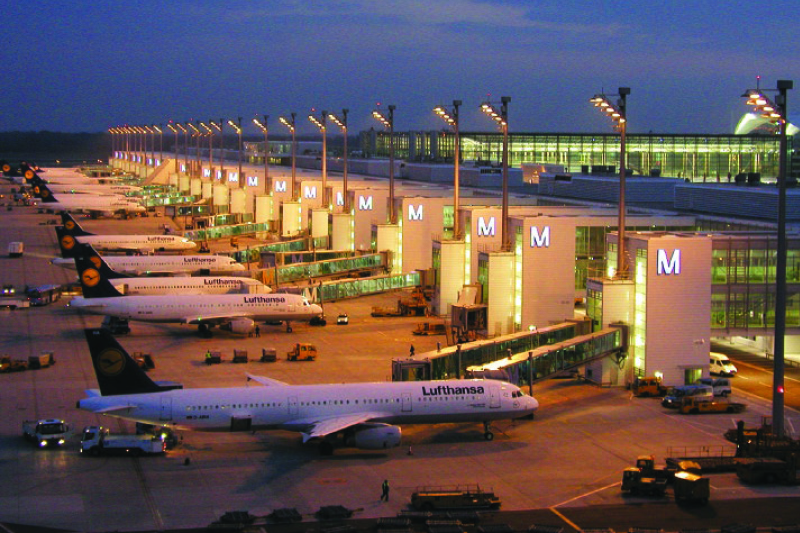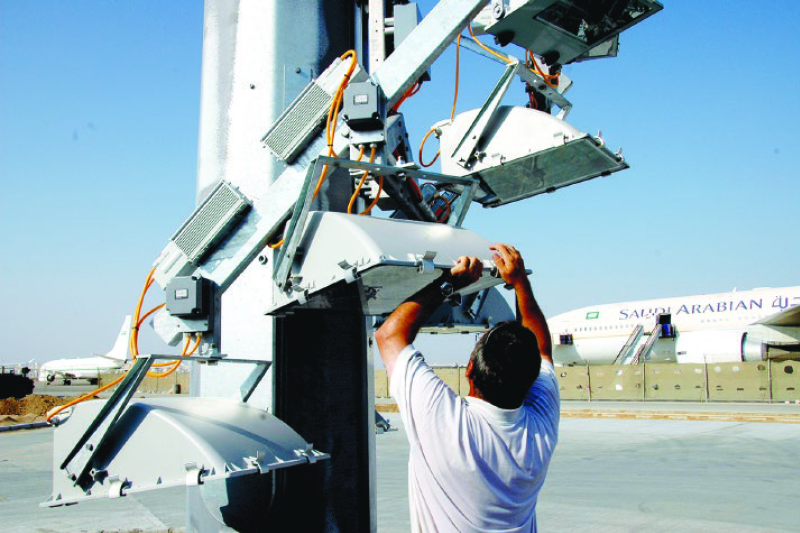Company Insight
Durable,
Low-Maintenance and Expandable – Next Generation Airport Lighting
Klaus Dengler, Managing Director Europoles Suisse GmbH), René Vuillemin, (Managing Director Europoles Suisse GmbH)
As airports grow and develop technologically, airport lighting systems also have to meet increasingly higher requirements. The trend is away from mere lighting poles towards flexible multi-functional systems.
Lighting for the World’s Transport Hubs
Hundreds of take-offs and landings a day, non-stop operation on runways, in terminals, in loading, unloading, servicing, waiting and security zones – on 365 days a year. Airports are international transport hubs where the safety of people, goods and technology takes top priority. Many airports are currently experiencing strong growth. Airlines are using larger aircraft and passenger and freight traffic is increasing. Airports are dynamic, globally operating commercial enterprises. It is critical that they run smoothly and economically. These are sophisticated challenges that can only be resolved on the basis of an equally efficient and reliable infrastructure. The apron areas of airports in particular are important pieces of the flight operations puzzle for parking, boarding and disembarking, aircraft handling, refuelling and taxiing. It is an intricate work of choreography in which every step has to mesh seamlessly with the next. Because one thing is clear: stoppages cost time and money and cause stress. Even just the unavailability of a scheduled apron space is associated with costs for the airport. In this context, the lighting on airport aprons plays a key role, because only under ideal lighting conditions can the safety of passengers, goods and aviation technology be guaranteed in all weathers. In turn, this means that all components of the lighting, from the lighting pole to the luminaire, have to meet the most stringent requirements.
As a leading manufacturer of lowerable systems in Europe, Europoles GmbH & Co. KG from Germany and its Swiss subsidiary Europoles Suisse GmbH know how to accommodate these requirements.

Image courtesy:
Smooth Non-Stop Operations
“Apron lighting has to be looked at quite differently from street lighting, for example,” explains Günter Sellmeier, Head of Outdoor Electrical Systems at Flughafen München GmbH [Munich Airport], “because there is a lot of money at stake here.” This means that the focus of customer requirements is on trouble-free operation, especially in the three key aspects of availability, maintenance and service life.
The expectations of system availability are naturally very exacting. The ideal scenario would be maximum durability and permanent availability in 24-hour operation. This is also the opinion of Günter Sellmeier: “As far as possible we would of course want the availability of apron lighting to be 100%.” It stands to reason that this is never completely guaranteed. However, if individual outages do occur, then the effects must not limit the use of the operational areas in any way. “As far as maintenance is concerned the opposite applies,” says Sellmeier. Basically, the less maintenance required the better! Because maintaining the systems costs time and money. Here too, if the occasion does arise, it must not interfere with ongoing operations. For many of those responsible for this area, a simple maintenance programme with fast repair times that does not block access to parts of the apron would be the catch-all solution. The service life of the products used plays an important role in the considerations of customers and designers/ planners. “As a customer I naturally expect that all elements of the lighting should last as long as possible. With regard to service life I am not especially concerned about the poles,” says Sellmeier. As commercial enterprises, airports are also always striving for growth, so when certain areas are being extended or added, it is perfectly possible also for lighting poles to be replaced or set up differently. “However, the original purpose of the aprons will not change,” he adds. The luminaires used should last for more than ten years without light loss or with just a minimal amount.

Image courtesy:
From Lighting Carrier to Multi-Functional System
Apart from growth, sustainability is a must for every airport nowadays. Günter Sellmeier sees an ongoing trend here: “There has been a lot happening in this area for years. Here at Munich Airport, for example, we have installed LED lighting outdoors.” From the point of view of sustainability, using LED technology not only enhances the status of an airport, it also upgrades its look. The basic trend is to reduce CO2 emissions and light pollution and undertake active lighting control, i.e. using light only where it is needed. In this context, detailed planning of lighting use and the location of lighting poles is essential. Nowadays, lighting poles also accommodate a great deal of additional equipment as well as the luminaires. This development is considered to be a whole new field, moving away from being just a lighting carrier to becoming a multi-functional system. As well as increasing use of antennae and camera systems, a lighting pole offers virtually unlimited installation options. At Munich’s “Franz Josef Strauß” Airport, one of the biggest in Europe with around 39.7 million passengers a year, “almost anything you can think of” is attached to the lighting poles, according to Günter Sellmeier. As well as the cameras already mentioned and which the airport has been using for seven years, the poles also function as carriers for LAN, radio and multilateration (MLAT). MLAT is a navigation system that processes the characteristic codes that almost every vehicle transmits on the apron and stores them accurately on a radar image. The location of aircraft and other vehicles can therefore be determined to an accuracy of half a metre. “There has always been this tendency to make additional use of the lighting pole and it is constantly becoming more widespread,” says Sellmeier. “What is important to us is that the system is capable of being extended, because the technology is constantly evolving and requirements are steadily increasing as a result.”

Image courtesy:
Economic Lowerable Lighting Systems
Generally, lighting poles for airport aprons have to offer a space-saving design and minimal footprint. In line with customer requirements, Europoles can produce floodlight poles in steel and pre-stressed spun concrete with variable pole details in heights of up to 60 metres. Depending on the intended purpose, climate and environment around the airport, poles made of galvanised steel are generally ideal for apron lighting. They are highly corrosion-resistant, protected against dirt and vandalism and extremely stable thanks to their low vibration characteristics. This makes them very durable and reduces costs for maintenance and premature replacement. In addition, steel poles do not need extra protection for transport, so there is no need for packaging material, the cargo capacity increases and freight costs can be saved. Steel poles are a very sustainable and economic solution, as are poles in pre-stressed spun concrete. Particularly in respect of the requirement for long service life, highly durable pre-stressed spun concrete poles are also ideal for use on the apron. And the spun concrete poles also have excellent sustainability credentials: they are 100% recyclable and have a very good ecological footprint thanks to the manufacturing process used, their construction method and extremely low maintenance requirement.
Customers can choose between various types of pole, from rigid poles to tiltable poles and poles with lowerable platform systems. However, unlike lowerable systems, rigid systems and tiltable poles cannot be maintained during operation, so closures and traffic management are necessary. For this reason a lot of preliminary work is necessary when planning maintenance. This results in high manpower costs for repairs and maintenance to tiltable and rigid poles, and the apron cannot be used during this period. To summarise, rigid systems and tiltable poles generate high costs during their service life and are therefore not efficient. The most economic systems are lowerable systems!
To meet customer requirements for efficient and cost-effective operation during the entire working cycle, Europoles Suisse GmbH has developed the NIVATEC lowerable system specifically for this purpose. Due to its outstanding features, this lowerable system is ideal for use on aprons. The development process focused mainly on safety and sustainability. The outcome was a single wire rope-rail system with brake and suspension device. This means that the system is firmly attached to the top of the pole during operation.
Thanks to this design, asymmetrical floodlight platforms are easily realised. The floodlights can be installed without any counterweight exactly according to the lighting calculation. Because the system is lowered on the safety rail, it can be serviced even in poor weather conditions like wind. And only one person is required to operate the system, guaranteeing the simple maintenance process that the customer requires without any planning effort.
Contact details
Europoles GmbH & Co. KG
Ingolstaedter Straße 51
92318 Neumarkt
Germany
Tel: +49 9181 896-0
Fax: +49 9181 896-1115
Email: info@europoles.com
Website: www.europoles.com
Europoles Suisse GmbH
Feldbach 10
8753 Mollis
Switzerland
Tel: +41 55 618 80-20
Fax: +41 55 618 80-28
Email: info.epsuisse@europoles.com
Website: www.europoles.com